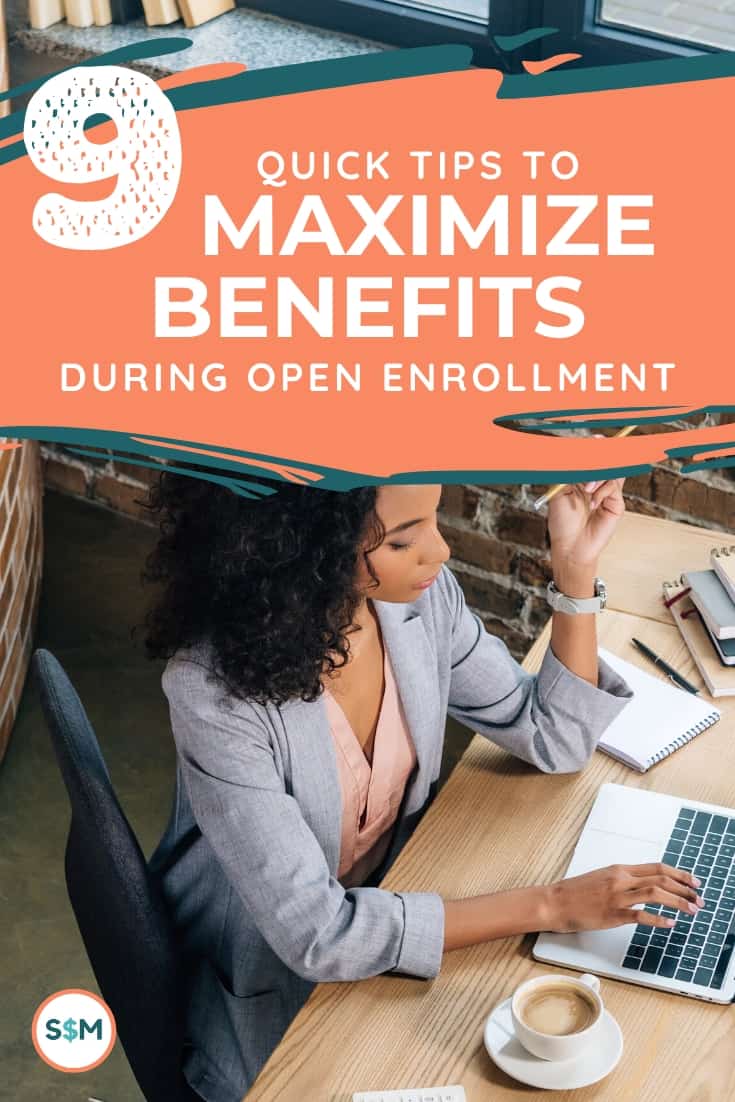It’s officially November. The leaves are on the ground, the air is chilled, and Halloween candy wrappers are stashed randomly around the house. And amid all this fall bliss, open enrollment season is kicking off.
The time of year where HR departments send out jargon-heavy emails, healthcare companies mail confusing documents on coverage levels, and you’re asked to select from this chaos the benefits that are best for you and your family.
Open enrollment might not be the most exciting time of year, but it is important. It’s your chance not only to best decide how to provide financial protection for your family but also to maximize the value of resources provided to you by your company. If you don’t take a few minutes to consider your options, you may be leaving money on the table.
So, before you go sneak another Reese’s, here are our best tips to help you navigate open enrollment like a pro.
Table of Contents
Top Tips for Choosing Benefits Open Enrollment
1 – Know Your Open Enrollment Dates (& Your Spouse’s)
General open enrollment for the U.S. healthcare marketplaces is November 1st through December 15th and most companies’ enrollment periods fall in a similar window. But – just to make things a little more confusing – private employers can choose any open enrollment period they prefer, as long as it’s the same each year.
Before diving into your options, make sure to check your company’s open enrollment dates. Put the final day on your calendar with a 24-hour reminder. You don’t want to miss the chance to elect benefits – especially if you want to make changes from last year.
If you’re married, check your spouse’s open enrollment dates as well. You may want to see if there is any overlap in your enrollment times so you can compare benefits and decide which is best for your family.
2 – Compare Insurance Plans Based on Total Health Insurance Cost
When it comes to health insurance, the lowest price isn’t always the best deal.
Health care plans have three main costs to be aware of: premiums, deductible, and max-out-of-pocket expenses.
Premiums are the price you pay each month to have insurance. The deductible is how much you need to pay in qualified medical expenses before insurance actually kicks in. And max-out-of-pocket, unsurprisingly, is the maximum amount you would have to pay in a year for medical care.
While a lower premium may look attractive, it likely comes with a higher deductible before your insurance actually kicks in. That’s alright if your family is generally healthy and you can budget for that deductible in your emergency fund. But if you have a family member with a chronic illness or special needs, you may be better off paying a higher monthly premium in exchange for lower deductibles and max-out-of-pocket expenses.
Consider your last year’s healthcare expenses and what you expect in the coming year (are you planning on having a baby?), then compare total cost across plans. How much would you expect to pay across the three main healthcare expenses based on your family’s health and plans? Use that comparison to plan accordingly.
Pro tip: Your state healthcare exchange will have a way to estimate the total cost based on your family’s age, health conditions, and lifestyle. Reach out to your HR department, who may be able to point you to a similar tool.
3 – Consider Tax-Advantaged Health Accounts
When premiums aren’t your only healthcare expenses – looking at you, deductibles, copayments, and eye doctor visits – you may have the option to cover those added costs with tax-advantaged savings.
HSAs (Health Savings Accounts) and healthcare FSAs (Flexible Spending Accounts) are accounts that allow you to contribute pre-tax dollars towards your healthcare expenses. Qualified expenses can include your deductible, copayments, prescription drugs, bandages, sunscreen, a trip to the orthodontist, physical therapy and more.
Because the contributions are made with pre-tax dollars, you reduce your taxable income that year. This saves you around $0.30 for each dollar contributed, depending on your income level.
When choosing your health plan, check whether you would be eligible for either an HSA or FSA and whether your employer matches any contributions to those accounts. Some employers contribute to HSA funds for employees who choose a high-deductible health plan, as it saves the company money on premiums as well as you.
4 – Don’t Overlook Disability Insurance
Many employees pass on short-term or long-term disability insurance, even when it’s offered to them. It can feel like an extra expense, even when it’s heavily subsidized by your employer. But this benefit can be of incredible importance in protecting your family’s financial security.
The U.S. Census Bureau states that the average employee has a 1 in 5 chance of becoming disabled at some point in their career. And only 5% of disabling accidents and illnesses are workplace-related. This means even if your job feels cushy or safe, you still could face time out of the workforce in your career.
So, if your emergency fund can’t handle 3, 6, or 12 months without your income – you need disability insurance.
Unfortunately, my first boss – the person who taught me about disability insurance – ended up needing his policy when he was diagnosed with cancer. If you’re curious about how long-term disability insurance works, and how to review what your company offers, I wrote a full overview of long-term disability insurance in his honor.
5 – Review Your Retirement Savings Options
If you were already contributing to a 401(k), 403B, or 457, your current contributions will likely carry into the next year, unless you elect to make a change. But open enrollment is a great time to review whether the corporate match has changed. And to make sure you’re contributing enough to get the full benefit of that match.
It’s also the perfect time to reflect on your budget and if you can afford increasing your contribution. Upping your retirement savings contribution even 1% a year can speed up your savings and better prepare you for the future.
Finally, be sure to check on how your money is invested. Do you have the proper asset allocation? Have you minimized fees? Do a health check of your accounts to make sure your money is working for you.
6 – Ask About Tax-Advantaged Dependent Care or Commuter Accounts
HSAs and FSAs aren’t the only benefit accounts that can be funded with pre-tax dollars. Some employers offer dependent care FSAs that can be used to cover childcare expenses, summer camps, costs to care for elderly parents, and more.
Pre-tax commuter benefits can be used for parking, public transportation, and rideshares. The IRS limit on these accounts is currently $285 a month for transit or parking, but when you’re reducing your taxable income, you’re still saving $85 to $115 on taxes a month!
Check whether dependent care FSAs, pre-tax commuter accounts, or any other tax-advantaged accounts are offered by your employer. Be sure to ask questions about how the funds can be used and how often you can change your contributions.
7 – Reassess Your Life Insurance Coverage
If your company offers life insurance benefits, now is the time to review how much coverage you actually have. Employer-based policies are often based on a multiple of your income. If you got a raise this year or moved to reduced time, your coverage may have shifted.
Make note of the provider of the life insurance plan and how your partner or family could file a claim if something happened to you. Oftentimes, your spouse may not know who to contact at your company or what coverage you had. The information is already in front of you as you click through to elect benefits, so it’s the perfect time to jot it down.
Also, it’s important to understand how much coverage you have, as employer-based plans are usually not enough to cover the full life insurance needs of a family. A common rule of thumb is 7-times your annual expenses, to help your family cover the mortgage, debts, and other expenses if you pass. In addition, your company policy won’t move with you if you leave the company. As life insurance gets much more expensive as you age, now is the time to fill any coverage gaps with your own policy.
8 – Check Your Beneficiaries
When making elections for your retirement accounts and life insurance you’ll be asked to choose a beneficiary. This is the person who will receive the payout from these accounts if anything ever happened to you. Make sure the person you chose is correct and up to date.
Life insurance and retirement accounts bypass probate and listed beneficiaries can even override your will. There are far too many stories of beneficiaries not being updated and life insurance going to an estranged parent, ex-spouse, or even ending up with a state conservator when the beneficiary was listed as a child under-18 that can’t yet legally inherit.
Take the opportunity of open enrollment to review your beneficiaries.
9 – Ask Questions About Additional Benefits
Healthcare, disability insurance, and life insurance are the major benefit areas. But many companies offer additional small benefits that can add up. Discounts on cell phone plans or computers. Reimbursements from gym memberships through your health insurance company. Corporate match on charitable gifts or a budget for ongoing education expenses. The range of benefits available is wide.
During open enrollment, these benefits are top of mind both for you and your company. Read through your benefits package to see where you might be overlooking small perks. And if you’re curious if a certain benefit is available? Reach out and ask. Worst case scenario, the answer is no. And even then, you may plant a valuable seed.
Don’t Leave Money on the Table During Open Enrollment
Our lives are busy and no one wants to spend a minute longer than necessary wading through jargon and frustrating paperwork. But even a few minutes using these tips or asking questions can help you save hundreds – if not thousands – of dollars. And ensure that you get the insurance coverage you need to best protect your family.
So during open enrollment, ask questions. If your company is offering a seminar to help you compare the available health plans, go and listen. Email HR with questions or call the providers offering the benefits. You’ll be better informed for this year and in the future. You got this, mama!
Have questions about open enrollment? Drop them in the comments or send me a message!




Chelsea, thanks for the informative and timely post; info for open enrollment came in the mail yesterday! Your video explaining HSA v. FSA was particularly helpful. It helped me make the right choice for my family. Thanks again!